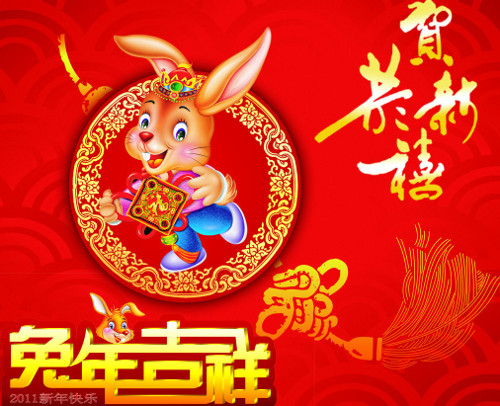
Key words in Chinese:
Spring Festival: 春节
Chinese New Year: 过年
Year of the Rabbit: 兔年
Festive atmosphere: 兔年大吉
Lunar calendar: 阴历/农历
Originally an agricultural festival, the Spring Festival falls on the first day of the Chinese lunar year, which is about twenty to thirty days behind the New Year of the Gregorian calendar. Dating back to the Shang Dynasty (approximately 17th-11th centuries BCE), it originated from activities involving offering sacrifices to deities or ancestors at the beginning of the year.
Farmers took advantage of this time of year to make wishes for a good harvest. Set on the second new moon after the winter solstice, it is part of a twelve-year cycle (12 Earthly Branches), each corresponding to an animal: rat, ox, tiger, rabbit, dragon, snake, horse, sheep, monkey, rooster, dog, and pig.
Like Christmas in Western countries, the Spring Festival is the most important festival in China. It is the day when all family members reunite. People who have left their hometown must return home. This is why, every year, more than ten days before the festival, transportation is more intense than ever. During these days, crowds flock like waves to train stations, bus stations, and airports.
The evening before the festival and the first three days of the first month are the most important. Setting off firecrackers is one of the representative traditions of the Spring Festival. The sound of firecrackers can drive away evil spirits, and people pray, to the sound of firecrackers, for peace and happiness.
Several traditional Chinese festivals originate from agricultural activities. In ancient times, when farmers harvested a bountiful crop, they organized public celebrations. During natural disasters, they made sacrifices to Gods and ancestors to seek their favor. Seasonal climate variations, such as spring blossoms and the bright autumn moon, also aroused in them the desire for good days. Eventually, such activities became frequent and turned into rites. The Spring Festival is the greatest celebration of this kind in China. As far as we know, it was originally a sacrifice made in winter in primitive society. Between the end of winter and the beginning of spring, the clan held a grand meeting where participants brought hunting, fishing, and agricultural products. They sacrificed these foods in thanksgiving to God, then the ancestors, for the blessings bestowed on nature (mountains, rivers, sun, moon, and stars). After the ceremony, they shared the offerings, dancing and singing to their heart's content.
The celebration was not regular at first. It later became a custom at the end of each winter. Over the years, it was set between the last days of the current year and the first days of the following year. After the collapse of primitive society, the sacrifice changed in form and content. It became a festival marking the departure of the past year and the arrival of the new year, hence the name Spring Festival.
The dates of traditional Chinese festivals are determined according to the lunar calendar. The Spring Festival marks the beginning of the Lunar New Year. It is also called Guo Nian in Chinese (literally: to pass 过 the year 年 ), but another etymology is given to this expression: "to keep away from the monster Nian."
There are various legends about the origin of Nian. The most widespread version is that Nian was a legendary ferocious animal of ancient times. It had the body of a bull and the head of a lion. Taking refuge in the depths of the mountains, it devoured small animals for its meals. In the depths of winter, due to a lack of sufficient game, it left its lair to go to nearby villages where it caught domestic animals and even humans. Fearful of its ferocity, the villagers fled their homes. Long afterward, people realized that Nian, although cruel, feared three things: the color red, bright fire, and loud noise. They thus found ways to prevent Nian from entering the village.
For this reason, before the intrusion of the monster Nian, the house door was painted red, and a fire was lit in front. In addition, the villagers struck objects to make noise. Thus, the beast no longer dared to enter.
This tactic later became a tradition that continues year after year. Later, people found that bamboo, once burned, produces an explosive sound. Over the years, burned bamboo gave way to firecrackers. It is in accordance with this tradition that the Chinese today still set off firecrackers during the Spring Festival.
